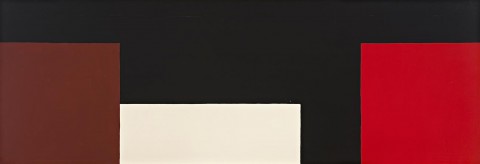UNTITLED, 1970
PETER BOOTH
synthetic polymer paint on canvas
156.0 x 455.0 cm
signed and dated twice verso: PETER BOOTH / 1970
inscribed verso: FOR MAGDA / 1983
Powell Street Gallery, Melbourne
Chris Deutscher, Melbourne,
acquired from the above c.1988
Private collection, Melbourne
Opening exhibition, Pinacotheca Gallery, Melbourne, 1970
Peter Booth, Pinacotheca Gallery, Melbourne, 25 August – 5 September 1970
Bluechip XVI: The Collector’s Exhibition, Niagara Galleries, Melbourne, 4 – 29 March 2014, cat. 8 (illus. in exhibition catalogue)
Writing about Peter Booth’s solo exhibition at Pinacotheca, Melbourne, in September 1970, Anne Galbally stated, ‘Booth reduces picture-making to the basic activity of setting color [sic] blocks of varying intensity and size on to uniformly black rectangles and squares. In doing so, he is making a serious attempt to understand the basic elements of structure. The shiny black reads as vast space and establishes the cream, brown, and red blocks as physical forces. Colors [sic] are not related to one another but are established by outline and density as separate entities, constantly testing and opposing one another’.1 One of five large-scale paintings and five related drawings included in the exhibition, Untitled, 1970 is a monumental expression of the power of abstraction. Painted two years after the National Gallery of Victoria opened its new premises on St Kilda Road with The Field, an exhibition that featured the work of young artists – including Booth – influenced by the various streams of contemporary American abstraction (including colour field, hard-edge minimalism and op art), it juxtaposes three coloured rectangular forms against a dense black ground, creating stark tonal contrasts that establish a spatial tension which reverberates across the canvas. These simple geometric shapes echo architectural forms and followed on from an earlier series of paintings that drew on Booth’s experience of working in various factories, describing the pattern of steel sheets and slabs on the factory floor.2
While at first glance, this painting looks like a typical example of hard-edge geometric abstraction of the late 1960s and early 70s, closer inspection reveals that just like Booth’s contribution to The Field, its ‘hand-painted edges are not hard and [its] surfaces are far from the carefully applied, gesture-free paint of minimalism’.3 Unlike many of his peers whose work was characterised by flat surfaces, crisp edges and bright colour, from the outset Booth’s painting showed a tendency towards painterly expression and atmospheric moodiness that would become more apparent in later years when he made the transition from abstraction to figuration, and would ultimately be recognised as one of the defining features of his oeuvre. In these paintings from 1970, other examples of which are held by the National Gallery of Australia, National Gallery of Victoria and Monash University Museum of Art, Booth used a gloss acrylic paint which both captured and reflected light in a particular way. In addition to bringing the viewer into the picture, this textured sheen adds to the movement and ‘life’ of the surface of an otherwise minimalist composition.
Booth has said that black is ‘strong and beautiful – the colour of the universe … The abstract paintings reflected my state of mind then. Whether a picture is abstract or figurative is not the issue – it’s what the painting says about the human condition’.4 The cool isolation of hard-edge minimalism totally removed from human experience and emotion was not for him and instead, Booth developed a uniquely personal variation within the familiar language of geometric abstraction to produce paintings that are as bold as they are quietly nuanced and which, in Ann Galbally’s words, demand absorption, but reward reflection.5
1. Galbally, A., ‘A reward from the minimum’ in The Age, Melbourne, 2 September 1970
2. Lindsay, R., ‘Hard Rain: The Iconography of Peter Booth’ in Smith, J., Peter Booth: Human/Nature, exhibition catalogue, National Gallery of Victoria, Melbourne, 2003, pp. 18 – 19
3. McPhee, J., ‘Peter Booth: Human/Nature’ in Art Collector, issue 26, October – December 2003, accessed online 13 May 2018.
4. The artist quoted in Smith, op. cit., p. 77
5. Galbally, op. cit.
KIRSTY GRANT
Peter Booth lives and works in Melbourne
SELECTED EXHIBITIONS
2006 Five Decades, TarraWarra Museum of Art, Victoria
2006 White Mantle – The Winter Landscape in Australian Art, Geelong Art Gallery, Victoria
2003 Peter Booth: Human / Nature, retrospective exhibition, National Gallery of Victoria, Melbourne
2002 Fieldwork: Australian Art 1968 - 2002, National Gallery of Victoria, Melbourne
2002 It’s a Beautiful Day: New Painting in Australia 2, Art Gallery of New South Wales, Sydney, and National Gallery of Victoria, Melbourne, 2002 – 2003
SELECTED LITERATURE
Smith, J. (ed.), Peter Booth: Human / Nature, exhibition catalogue, National Gallery of Victoria, Melbourne, 2003
Fieldwork: Australian Art 1968 - 2002, exhibition catalogue, National Gallery of Victoria,
Melbourne, 2002
Lindsay, R., Peter Booth: Recent Paintings, exhibition catalogue, Deutscher Brunswick Street, Melbourne, 1990
Catalano, G., Australia: Venice Biennale 1982: Works by Peter Booth and Rosalie Gascoigne, exhibition catalogue, Visual Arts Board, Australia Council, Sydney, 1982
SELECTED COLLECTIONS
Art Gallery of Ballarat, Victoria
Art Gallery of New South Wales, Sydney
Art Gallery of South Australia, Adelaide
Art Gallery of Western Australia, Perth
Bendigo Art Gallery, Victoria
Centro Cultural / Arte Contemporaneo, Mexico City, Mexico
Geelong Art Gallery, Victoria
Heide Museum of Modern Art, Victoria
Ian Potter Museum of Art, University of Melbourne, Melbourne
Metropolitan Museum of Art, New York, USA
Monash University Museum of Art, Melbourne
Mornington Peninsula Regional Gallery, Victoria
Museum of Contemporary Art Australia, Sydney
Museum of Modern Art, New York, USA
National Gallery of Australia, Canberra
National Gallery of Victoria, Melbourne
Newcastle Art Gallery, New South Wales
Queensland Gallery of Art / Gallery of Modern Art, Brisbane
Queen Victoria Museum and Art Gallery, Launceston
Solomon R. Guggenheim Museum, New York, USA
TarraWarra Museum of Art, Victoria
Tasmanian Museum and Art Gallery, Hobart
University of New South Wales, Sydney
Wollongong City Art Gallery, Victoria
REPRESENTED BY
Chris Deutscher, Melbourne
